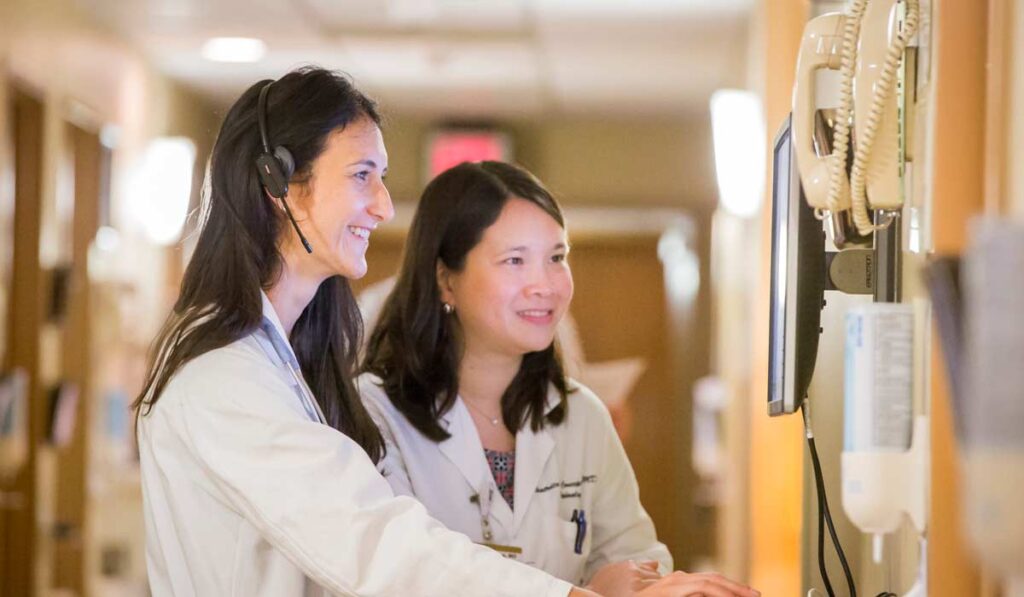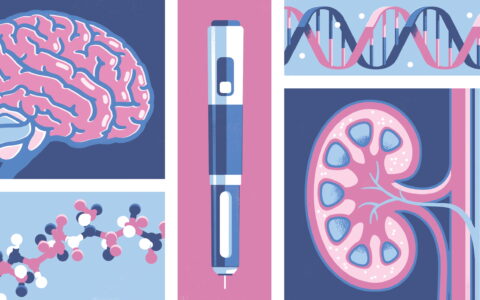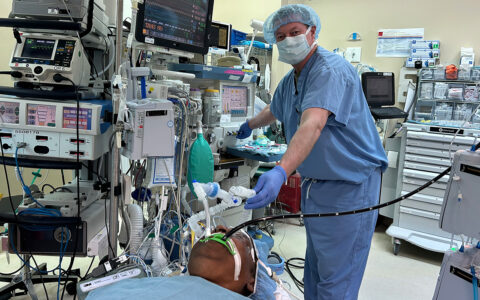Vanderbilt University Medical Center performed its first kidney transplant in October 1962 — then the first organ transplant in Nashville and one of the first in the South. Almost sixty years later, Vanderbilt transplant surgeons have performed more than 6,000 kidney transplants.
Discoveries spoke with Rachel Forbes, M.D., newly appointed chief of the Division of Kidney and Pancreas Transplantation, and Beatrice Concepcion, M.D., associate medical director of the kidney-pancreas transplant program, regarding the current state of kidney transplant, research priorities and advances in patient care.
Expanding Organ Access
Discoveries: Dr. Forbes, in addition to your leadership roles at Vanderbilt, you serve on the UNOS Pancreas Committee that recently announced updates to the Kidney and Pancreas Allocation System. What is the current state of kidney and pancreas access in the U.S. and what do these allocation changes mean for organ recipients?
Forbes: We’ve seen increased growth in kidney transplant need – there are over 100,000 on the waitlist, and only about 18,000 receive kidneys nationally each year. Pancreas transplant need has gone up slightly as well.
The committee’s goal was to ensure continuous distribution of organs. We changed the allocation guidelines so the right organ goes to the person who needs it most, instead of staying within a geographical boundary. There are also substantive changes to the policy and process for “local backup” of these organs if the original intended recipient is unable to be transplanted.
“We changed the allocation guidelines so the right organ goes to the person who needs it most, instead of staying within a geographical boundary.”
Increasing Viable Kidneys
Discoveries: Dr. Concepcion, the use of hepatitis C (HCV) viremic donor organs is helping to increase the donor pool. What are you learning about outcomes in HCV kidney recipients?
Concepcion: Our program began transplanting kidneys from HCV viremic donors into uninfected recipients in July 2018 and since then we have transplanted close to 80 patients. We’ve had an HCV cure rate of 98 percent utilizing direct-acting antivirals after transplant. Increased use of organs from viremic donors not only improves access to transplantation for our patients but also provides them with good outcomes.
“We’ve had an HCV cure rate of 98 percent utilizing direct-acting antivirals after transplant.”
We’re also exploring ways to reduce viral transmission into recipients. Recently, we published the results of a prospective pilot study using ex vivo pump perfusion to optimize organs from HCV donors and potentially decrease transmission risk. Although it was a negative study, it serves as groundwork for future studies in this arena.
Discoveries: Where does work stand on developing an artificial kidney?
Forbes: Through The Kidney Project, William Fissell, M.D., at Vanderbilt and researchers at the University of California, San Francisco have made great strides in developing a prototype bioengineered kidney. There are several other exciting initiatives in transplant research including geno-transplantation, use of pig kidneys in humans and growing stem cell kidneys.
Minority Transplant Considerations
Discoveries: There has been strong emphasis in recent years on increasing organ access to counter racial and ethnic disparities, especially for Black patients. What are some effective strategies?
Forbes: We had hoped that the Kidney Allocation System guidelines implemented in 2014 would increase access for women, children and minorities – and they have. These guidelines permitted A2 to B deceased donor kidney transplantation to improve access and wait times for Black patients. There are more A blood type kidney donors; Blacks have more B and O.
We were one of the early adopters of A2 to B transplants and published a paper in 2019. What we found was that A2 to B transplants did improve disparities for Black patients. While anti-A titers increased significantly post-transplantation – even using desensitization – there were no significant differences in patient or graft survival.
“What we found was that A2 to B transplants did improve disparities for Black patients.”
In addition to this single center experience, we are participating with a national consortium of centers on the NIH-funded APOLLO study looking at the APOL1 gene high-risk alleles in kidney donors with African ancestry. Kelly Birdwell, M.D., is principal investigator at Vanderbilt.
Improving Patient Survival
Discoveries: One of the overarching themes of your research is improving post-transplant outcomes for kidney recipients. Can you talk about some of these projects?
Concepcion: We have several studies funded by the Vanderbilt Institute for Clinical and Translational Research. Some of our current work has been focused on kidney transplant recipients with failing allografts. These patients are at increased risk for death after returning to dialysis compared to patients who start dialysis and have never received a transplant. The aim is to understand why that is and how this risk can be mitigated.
We also recently concluded a qualitative study exploring patients’ perceptions in their transition from allograft loss to dialysis. We hope to understand what patients go through, where they get their support, and how we can better care for them during this difficult transition. We’ve finished analyzing the data and are in the process of drafting a manuscript.
“We hope to understand what patients go through, where they get their support, and how we can better care for them during this difficult transition.”
Forbes: We’re also participating in numerous multi-site studies exploring new therapies. As a single center, we have a study looking at neurocognitive function after transplantation. Seth Karp, M.D., is leading a study comparing bariatric surgery and medical management in obese patients needing kidneys.
Kidney Transplant and COVID-19
Discoveries: Dr. Forbes, in your role as surgical director of the Vanderbilt Living Kidney Donor Transplant program, you’ve been instrumental in reorganizing the donor evaluation workflow to increase living donor transplants. How has the COVID-19 pandemic affected kidney transplantation from living donors?
Forbes: We performed 260 kidney transplants at Vanderbilt last year and 60 of those were living donors. While total donations this year have tracked with 2019, because of hospital restrictions on surgery and fear of contracting the virus, living donations have dropped significantly. Vanderbilt has developed a unique model for working with our regional organ provider and outside centers to facilitate transplant during the pandemic.
Discoveries: How has telemedicine played a role in managing patients during the pandemic?
Concepcion: We were ahead of the curve on telemedicine; we have been utilizing this modality since 2018. During the pandemic, telemedicine has allowed us to provide care to our patients while reducing risk of exposure for both patients and staff.
Forbes: I think we’re all discovering new ways to meet our patients’ needs, while continuing to provide the best outcomes possible.






